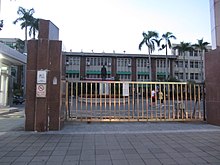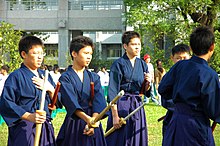301:
293:
147:
131:
405:
316:
proportion of genders. In the 39th academic year (August 1950 to July 1951), there were 40,670 boys, which nearly doubled that of the 20,412 girls. However, as of the 101st academic year (August 2012 to July 2013), the difference in the proportion of boys and girls significantly reduced, where there was 440,711 boys and 404,173 girls. This indicates that under the compulsory education policy and the rise in
312:(中華民國教育統計), Taiwan has 932 junior high schools in total, 844,884 students and 880 full-time teachers in those schools, as of the 101st academic year (August 2012 to July 2013). There has been a steep increase in those numbers since the implementation of nine years of compulsory education, which reflects the growth and changes in the junior high school education in Taiwan.
419:
389:(8,099), where they sum up to comprise 84.30% of the total number of new-immigrant student population. As for overseas Taiwanese, there were 206 students who returned to Taiwan to attend a junior high school in the 98th academic year (August 2009 to July 2010), mainly those residing in Indonesia (60), followed by the
458:
320:, the education conditions for girls have improved. In addition to this, the promotion rates of students in junior high schools increased from 51.15% to 99.15% from the 39th to the 101st academic year. In other words, currently in Taiwan, almost every student can be promoted and pursue further studies.
266:
system. A school year consists of two semesters, with the fall semester begins in early
September every year and runs through late January or early February. The spring semester begins in mid February and ends in early June. Semester breaks typically last for around two or three weeks surrounding the
283:
In junior high schools, subjects covered including literature, mathematics, English, science, technology, social studies, home economics and craft, arts and physical education. The language used in both junior and senior high schools is
Mandarin at all levels. However, English classes are mandatory
315:
For students, the proportion of the number of students dropped from 93.96% in the 39th academic year (August 1950 to July 1951) to 50.18% in the 98th academic year (August 2009 to July 2010), showing the change in the educational structure of Taiwan. Another fact worth mentioning is the change in
253:
Several educational reforms were vastly promoted, which included the extension and normalization of education and independent learning. The calls for extension of years of education started in 1983, and came to a consensus in 2003. It was announced in 2011 that the Twelve Years of Basic
Education
254:(十二年國民基本教育) will be implemented three years later, where education in Taiwan will be extended from nine years to twelve years, while the current promotion system to a senior high school will be abolished. This causes a fundamental impact on Secondary education in Taiwan.
462:
reads, "Wherever the laws and regulations in force specifies the amount of monies in the currency unit of Yuan (圓), Silver Yuan, or Yuan (元), that is three times the New Taiwan Dollar." Therefore the highest fine of, e.g. "100 yuan", stated in all laws of the
177:
in Taiwan. Children and youths aged 6 to 15 are required to receive nine years of compulsory education. By law, every pupil who completed his or her primary education must attend a junior high school for at least three years, with exemptions to
328:
For schools, in the 39th academic year, there were only 66 junior high schools. After the implementation of compulsory education, junior high schools were set up to meet the goal of One Junior High School in Each
Township (一鄉鎮一國中). In the
247:
246:
Upon completion of studies in a junior high school, students may opt to pursue further studies or enter workforce. For those pursuing further studies, 2014 graduates could take the
207:. In 1896, Taiwan's colonial government implemented the policy of Direct Schools System, which was the first modern schooling system with reference to the Western system in the
523:
492:
353:
education, there were 72,652 aboriginal students studying in junior high schools in the 101st academic year. The first five groups in terms of student population are:
300:
498:
240:
374:
773:
292:
612:
146:
130:
529:
502:
373:(4,600). In that academic year, there were a total of 41,525 students who were new immigrants; sorted by the nationality (non-
583:
232:
208:
31:
437:
378:
45:
768:
459:
Regulation for the exchange rate between New Taiwan
Dollars and the fiat currency in the laws of the Republic of China
204:
628:
211:. Japan later made three revisions to the educational policy in Taiwan and made use of education to promote
338:
350:
174:
432:
107:
243:
implemented nine years of compulsory education to enhance the level of knowledge of
Taiwanese.
692:
688:
608:
579:
464:
236:
151:
424:
76:
575:
263:
216:
183:
155:
182:
and severe disorder or disabilities. Legal guardians of offenders may be subjected to
762:
658:
410:
390:
362:
358:
268:
179:
139:
135:
239:. The current secondary education system in Taiwan was formed in 1968, in which the
370:
366:
97:
83:
267:
Spring
Festival and Lunar New Year. Statistics on education are according to each
190:
300, where penalties may be repeatedly imposed until offenders return to school.
354:
330:
272:
228:
400:
212:
710:
696:
604:
567:
386:
634:
418:
317:
750:
382:
104:
299:
291:
145:
129:
556:. Cambridge, Massachusetts: Harvard Univ. Press. pp. 13–78.
468:
334:
203:
The history of secondary education in Taiwan dates back to the
187:
112:
250:(國中教育會考) or the Special Entrance Examination (特色招生考試).
751:
742:
88:
16:
Overview of the secondary education system of Taiwan
103:
96:
82:
75:
70:
58:
44:
30:
21:
284:throughout the whole secondary education period.
553:Japanese Colonial Education in Taiwan, 1895–1945
333:of 2009, the total expenditure on education was
310:Educational Statistics of the Republic of China
653:
651:
377:) of a parent, the first three countries are:
241:Ministry of Education of the Republic of China
173:(year 10–12). Junior high school education is
50:
36:
8:
165:refers to the Taiwanese education system in
674:
672:
670:
668:
67:
743:Ministry of Education, Republic of China
231:ended and Taiwan was handed over to the
150:National Fongshan Senior High School in
484:
449:
271:, while expenditures according to each
728:(in Chinese). 台北市: 中華民國教育部. p. 5.
345:Aboriginal and non-Taiwanese education
337:802.3 billion, which was 5.83% of the
18:
633:(in Chinese). 中華民國教育部. Archived from
528:(in Chinese). 中華民國教育部. Archived from
304:Taiwanese junior high school students
296:Taiwanese junior high school students
7:
279:Subjects and medium of instruction
14:
417:
403:
248:Comprehensive Assessment Program
113:
774:Secondary education by country
209:history of education in Taiwan
89:
51:
37:
1:
572:日本統治下臺灣的學校教育:其發展及有關文化之歷史分析與探討
438:K-12 Education Administration
163:Secondary education in Taiwan
22:Secondary education in Taiwan
726:《新移民子女就讀國中小人數分布概況統計(101學年度)》
550:E. Patricia Tsurumi (1977).
134:Dalin Junior High School in
790:
379:People's Republic of China
124:
66:
26:
725:
680:
629:
600:
571:
524:
493:
32:Traditional Chinese
46:Simplified Chinese
339:Gross domestic product
305:
297:
233:Nationalist Government
159:
143:
62:National Middle-school
659:"Education in Taiwan"
303:
295:
149:
133:
227:In August 1945, the
769:Education in Taiwan
467:, is equivalent to
433:Education in Taiwan
215:and loyalty to the
306:
298:
171:senior high school
167:junior high school
160:
144:
114:Kok-bîn Tiong-ha̍k
465:Republic of China
308:According to the
237:Republic of China
223:Republic of China
128:
127:
120:
119:
77:Standard Mandarin
781:
755:
747:
730:
729:
724:教育部統計處 (2013).
721:
715:
714:
707:
701:
700:
679:教育部統計處 (2010).
676:
663:
662:
655:
646:
645:
643:
642:
625:
619:
618:
596:
590:
589:
564:
558:
557:
547:
541:
540:
538:
537:
520:
514:
513:
511:
510:
501:. Archived from
489:
472:
454:
427:
425:Education portal
422:
421:
413:
408:
407:
406:
262:Taiwan uses the
116:
115:
92:
91:
68:
54:
53:
40:
39:
19:
789:
788:
784:
783:
782:
780:
779:
778:
759:
758:
753:
745:
739:
734:
733:
727:
723:
722:
718:
709:
708:
704:
682:
678:
677:
666:
657:
656:
649:
640:
638:
631:
627:
626:
622:
615:
602:
598:
597:
593:
586:
573:
566:
565:
561:
549:
548:
544:
535:
533:
526:
522:
521:
517:
508:
506:
495:
491:
490:
486:
481:
476:
475:
455:
451:
446:
423:
416:
409:
404:
402:
399:
347:
326:
290:
281:
264:Minguo calendar
260:
225:
217:Empire of Japan
201:
199:Empire of Japan
196:
169:(year 7–9) and
90:Guómín Zhōngxué
59:Literal meaning
17:
12:
11:
5:
787:
785:
777:
776:
771:
761:
760:
757:
756:
748:
738:
737:External links
735:
732:
731:
716:
702:
687:(in Chinese).
664:
661:. 7 June 2016.
647:
620:
613:
603:(in Chinese).
591:
584:
574:(in Chinese).
559:
542:
515:
497:(in Chinese).
483:
482:
480:
477:
474:
473:
448:
447:
445:
442:
441:
440:
435:
429:
428:
414:
398:
395:
346:
343:
325:
322:
289:
286:
280:
277:
259:
256:
224:
221:
200:
197:
195:
192:
156:Kaohsiung City
126:
125:
122:
121:
118:
117:
110:
101:
100:
94:
93:
86:
80:
79:
73:
72:
71:Transcriptions
64:
63:
60:
56:
55:
48:
42:
41:
34:
28:
27:
24:
23:
15:
13:
10:
9:
6:
4:
3:
2:
786:
775:
772:
770:
767:
766:
764:
752:
749:
744:
741:
740:
736:
720:
717:
712:
706:
703:
698:
694:
690:
686:
675:
673:
671:
669:
665:
660:
654:
652:
648:
637:on 2012-11-29
636:
632:
630:十二年國民基本教育推動緣起
624:
621:
616:
614:9789577483287
610:
606:
599:彭煥勝 (2009).
595:
592:
587:
581:
577:
569:
563:
560:
555:
552:
546:
543:
532:on 2019-06-09
531:
527:
519:
516:
505:on 2019-06-04
504:
500:
496:
488:
485:
478:
470:
466:
461:
460:
456:Article 2 of
453:
450:
443:
439:
436:
434:
431:
430:
426:
420:
415:
412:
411:Taiwan portal
401:
396:
394:
392:
391:United States
388:
385:(10,690) and
384:
380:
376:
372:
368:
364:
360:
356:
352:
344:
342:
340:
336:
332:
323:
321:
319:
313:
311:
302:
294:
287:
285:
278:
276:
274:
270:
269:academic year
265:
257:
255:
251:
249:
244:
242:
238:
234:
230:
222:
220:
218:
214:
210:
206:
205:Japanese rule
198:
193:
191:
189:
185:
181:
180:homeschooling
176:
172:
168:
164:
157:
153:
148:
141:
140:Chiayi County
137:
132:
123:
111:
109:
106:
102:
99:
95:
87:
85:
81:
78:
74:
69:
65:
61:
57:
49:
47:
43:
35:
33:
29:
25:
20:
754:(in Chinese)
746:(in Chinese)
719:
705:
684:
639:. Retrieved
635:the original
623:
594:
562:
554:
551:
545:
534:. Retrieved
530:the original
518:
507:. Retrieved
503:the original
487:
457:
452:
375:ROC national
369:(8,113) and
348:
327:
314:
309:
307:
282:
261:
252:
245:
226:
202:
170:
166:
162:
161:
98:Southern Min
84:Hanyu Pinyin
691:: 中華民國教育部.
525:《強迫入學條例》第九條
349:As for the
331:fiscal year
273:fiscal year
229:Pacific War
763:Categories
641:2011-07-01
585:9576964210
536:2011-07-01
509:2011-07-01
479:References
381:(16,221),
365:(12,946),
361:(13,410),
357:(26,113),
351:aboriginal
213:militarism
175:compulsory
697:0578-1361
681:2010年教育統計
578:: 新自然主義.
570:(2000).
387:Indonesia
685:中華民國教育統計
607:: 麗文文化.
397:See also
318:feminism
288:Students
152:Fongshan
499:中華民國教育部
494:《國民教育法》
383:Vietnam
341:(GDP).
324:Schools
235:of the
194:History
105:Hokkien
711:"Home"
695:
611:
582:
393:(29).
363:Paiwan
359:Atayal
258:Period
186:up to
601:台灣教育史
444:Notes
371:Truku
367:Bunun
184:fines
136:Dalin
693:ISSN
609:ISBN
580:ISBN
471:300.
469:NT$
355:Amis
335:NT$
188:NT$
52:国民中学
38:國民中學
689:臺北市
605:高雄市
576:新北市
568:林茂生
108:POJ
765::
683:.
667:^
650:^
275:.
219:.
154:,
138:,
713:.
699:.
644:.
617:.
588:.
539:.
512:.
158:.
142:.
Text is available under the Creative Commons Attribution-ShareAlike License. Additional terms may apply.


